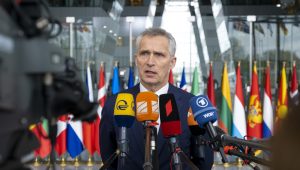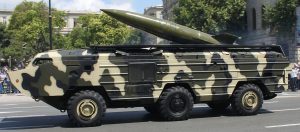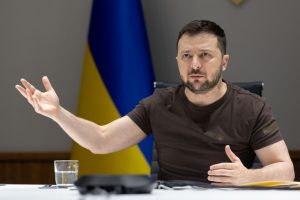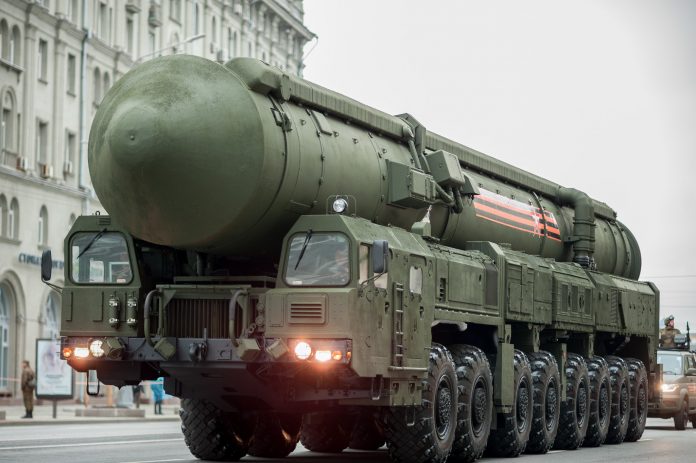The Russian military has used conventional weapons in its invasion of Ukraine. An exception was the phosphorus bombs that Russia allegedly used during the siege of “Azovstal” in Mariupol. However, Russian officials often cite the possibility of using their country’s nuclear arsenal to intimidate the Ukrainian government and the West. Finland and Sweden’s decision to seek NATO membership has sparked new outrageous statements and threats.
On the American side, the director of the National Intelligence Service, Avril Haines, told the Senate Armed Services Committee on April 10 that the Russian invasion could become “more unpredictable and potentially escalating” as “Putin’s strategic goals probably do not have change.”
CIA Director William Burns also said on April 17 that the United States could not “take lightly” the possibility of Russia using regular nuclear weapons, as the outcome of the war in Ukraine was going badly.
“Given the potential desperation of [Russian] President [Vladimir] Putin and the Russian leadership, given the setbacks that they’ve faced so far militarily, none of us can take lightly the threat posed by a potential resort to tactical nuclear weapons or low-yield nuclear weapons,” said Burns, as reported by Reuters.
There is a substantial difference between tactical and strategic nuclear warheads. The former can cause significant property damage and massive human losses, are smaller in dimension and could be used to a limited extent. Strategic nuclear bombs have a thumping potential for destruction.
Russia’s threats probably refer to the regular nuclear weapons, not strategic ones – although various Kremlin clownish figures suggest otherwise – because using the latter would be tantamount to suicide.
However, neither the US Central Intelligence Agency (CIA) nor NATO considers the Russian threat imminent.

On their side, the Ukrainian President Volodymyr Zelenskyy and other officials consider that Vladimir Putin is “bluffing” once again. In addition, some officials believe it is “not technically easy” for Russia to use tactical nuclear weapons against Ukraine.
How possible is a Russian nuclear attack?
On February 27, the president of the Russian Federation placed Russia’s nuclear deterrent forces on high alert. Although information coming from Moscow is limited, Putin’s order caused the reaction of a significant part of the executives of the Federal Security Service of the Russian Federation (FSB), an organisation that Putin does not fully control.
Avril Haines estimates that Kremlin threats to use nuclear weapons against European targets to prevent the United States and its allies from supplying more military equipment to Ukraine. The Russian president could approve new nuclear exercises as a signal to the West only “if he perceived an existential threat to the Russian state or regime.” “We have not seen much practical evidence to support this concern,” she said.
In a radio interview, the well-known journalist of the Bellingcat investigative website, Hristo Grozev, had stated on March 28 that Putin could try to use nuclear weapons, but his order may not be obeyed.

Russian OTR-21 Tochka missile. Capable of firing a 100 kiloton nuclear warhead at a distance of 185 km. [CC BY-SA 3.0]
The vague threats of Russia
The Russians are threatening to use their nuclear weapons, but the frequent invocation of the threat no longer causes terror. Their threats are vague and with many “ifs and buts.”
Thus, the Russian news agency TASS in May 12 hosted an excerpt from an interview with the First Deputy Permanent Representative of Russia to the UN, Dmitry Polyansky. The Russian diplomat stressed that Russia would use its nuclear arsenal if its existence came under threat.
Earlier on March 29, in an interview with PBS Newshour, Kremlin spokesman Dmitry Peskov also said Russia would use nuclear weapons only when its existence is under threat. However, he added that the outcome of the Russian invasion of Ukraine is independent of the use of nuclear weapons.
“We have a concept of security, which clearly states that only when there is a threat to the existence of the state in our country, we can use and will actually use nuclear weapons to eliminate the threat or existence of our country,” said Peskov.
Discussions on Sweden and Finland joining NATO have exacerbated the situation between Russia and the West.
On April 14, Dmitry Medvedev, Vice President of the Security Council of Russia and former President (2008 to 2012) and Prime Minister (2012 to 2020) of the Russian Federation, warned NATO that Moscow would develop nuclear weapons and supersonic missiles in Kaliningrad in case Sweden and Finland join the Atlantic Alliance.
But threats often give way to softer statements when the Kremlin realises it is in danger of being taken seriously in the West.
In an interview with India Today television on April 19, Foreign Minister Sergei Lavrov said Russia would use only conventional weapons in Ukraine.
Most notable is Putin’s stance on Saturday (May 14) during a telephone conversation with his Finnish counterpart Sauli Niinisto. Putin told his interlocutor that Finland’s decision was a mistake that would affect relations between the two countries. No threats of nuclear war!
Even the threat to transport nuclear warheads to the Kaliningrad Peninsula is vague and technically complicated.
Ukrainians remain calm and vigilant
For his part, the Ukrainian president, in an interview with the German newspaper Die Zeit on March 10, said that Russia was aware of the catastrophic consequences of the nuclear war and considered the Kremlin rhetoric about the possibility of using nuclear arms a bluff.
“Putin’s threat shows his weakness. Nuclear weapons are threatened only if nothing else works. I am convinced that Russia is aware of the catastrophic consequences of the attempt to use nuclear weapons,” said Zelenskyy.

Ukrainian President Volodymyr Zelenskyy.
However, in an interview with CNN on April 17, he admitted that there is such a possibility. “Ukraine should not be afraid, but be ready,” he stated.
However, two days earlier, Oleksiy Motuzyanyk, a spokesman for Ukraine’s Defense Ministry, said that the Ukrainian authorities and their Western allies “see no signs that Russia is preparing to use nuclear weapons in Ukraine.”
Also, Kirill Budanov, head of the Defense Ministry’s Central Intelligence Agency, said on April 17 (as reported by the news site nv.ua) that Russia’s use of nuclear weapons was unlikely and still “technically not so easy.” “Everyone, calm down! It is just a threat,” he said.
The “red button” in a rogue state
But how capable is the Kremlin regime of carrying out its threats? As we have mentioned, investigative journalist Hristo Grozev told the Ukrainian “Ukraine 24” that sources of the Bellingcat website had warned since December 2021 that Putin could decide to use nuclear weapons. “But,” he added, “he cannot use nuclear weapons with a conditional red button.”
“This red button exists, but there are five people who must follow all these instructions in a chain before a nuclear-powered missile takes off. Our sources are sure that there will be at least a few of these five who do not comply with this order,” he explained.
According to the journalist, Putin understands that there is such a danger, “so he is unlikely to give this order.”
Russia’s invasion of Ukraine has revealed that Russia is not a superpower. Maybe not even a considerable regional power. Its military, economic and diplomatic range proved limited. Several myths about Russia’s force have collapsed. In addition, Western sanctions have pushed the country to the brink of bankruptcy. In Putin’s hands, Russia became a rogue state.
The Putin regime is now waging a “life or death” battle. A possible withdrawal of his army from Ukrainian territory would be tantamount to overthrowing him. And this possibility no longer seems unlikely.

